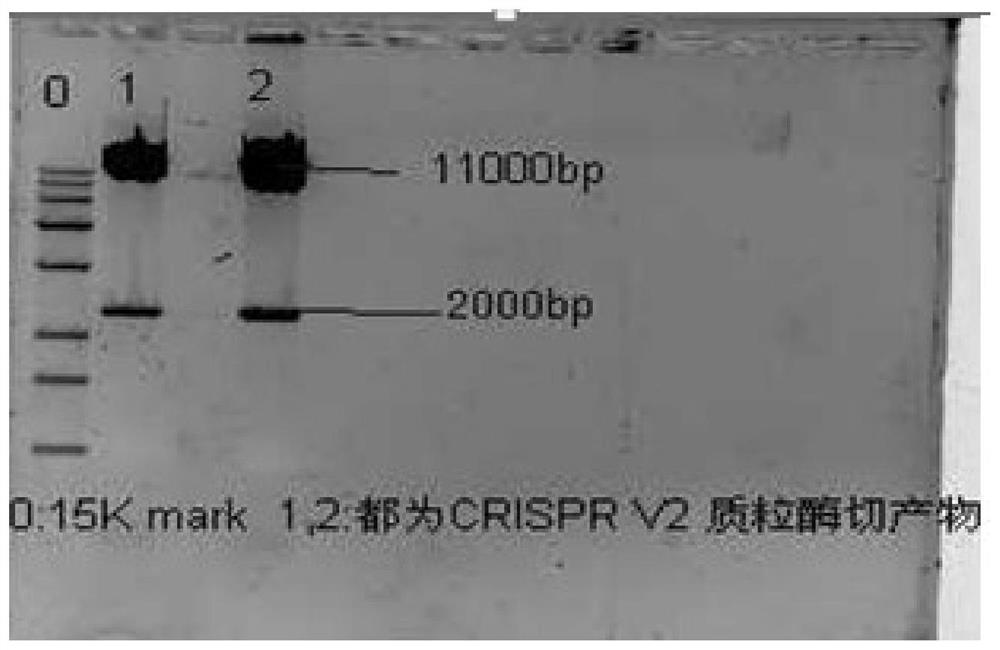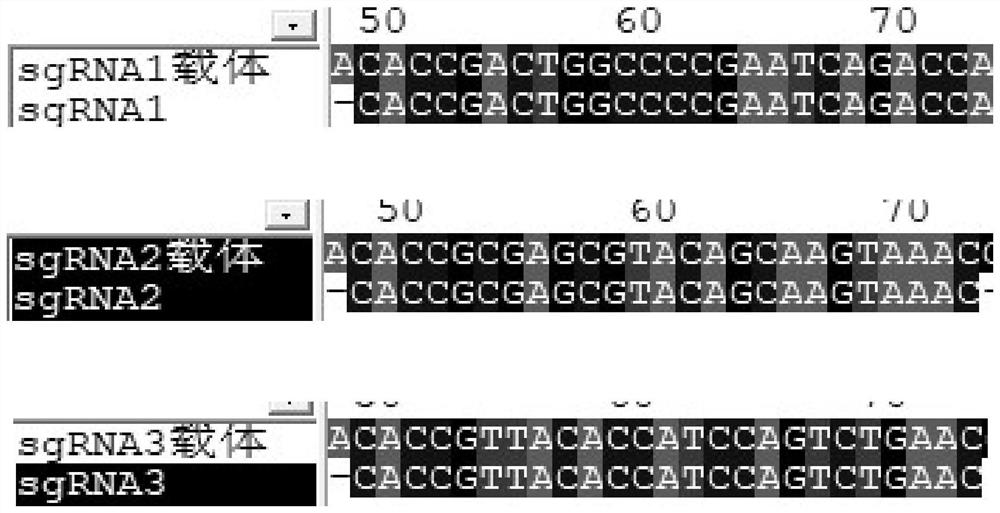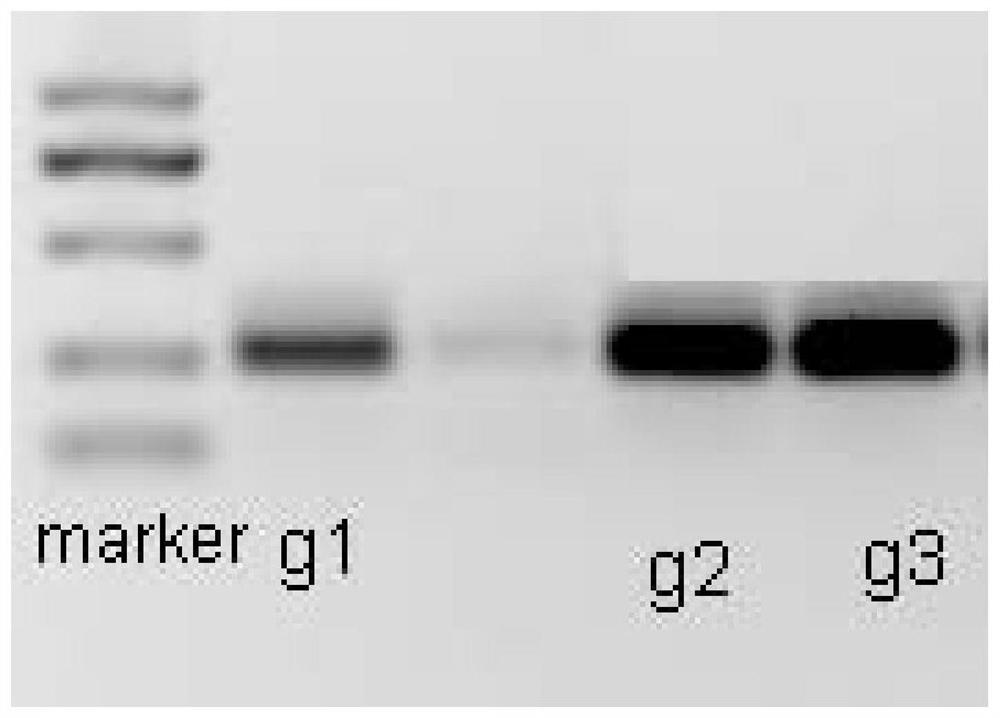Method for constructing EPB41 gene knockout THP-1 cell line based on CRISPR-Cas9 system
A THP-1, gene knockout technology, applied in the biological field, can solve the problems of low fertility and long reproductive cycle of mice
- Summary
- Abstract
- Description
- Claims
- Application Information
AI Technical Summary
Problems solved by technology
Method used
Image
Examples
Embodiment 1
[0043] Example 1 A method for constructing a cell line that knocks out the EPB41 gene based on CRISPR-Cas9 editing technology
[0044] 1. Design of sgRNA and synthesis of oligonucleotide chains. Three sgRNAs were designed for the No. 1 exon, No. 4 exon and No. 7 exon of human EPB41 gene, and the oligonucleotide chains were synthesized. synthesis. Target sequences are shown in Seq-No.1, Seq-No.2 and Seq-No.3.
[0045] 2. LentiCRISPR v2 digestion
[0046] (1) LentiCRISPRv2 digestion and terminal dephosphorylation:
[0047]
[0048] Cut at 37°C for 30 minutes.
[0049] (2) 1% agarose gel electrophoresis detection (results see figure 1 ); TIANgel Midi Purification Kit gel recovery LentiCRISPRv2 large fragment, concentration determination.
[0050] 3. Construction of LentiCRISPR v2 vector
[0051] (1) Annealing and phosphorylation of gRNA primers:
[0052] Oligo 1 (100 μM) 1 μL
[0053] Oligo 2 (100 μM) 1 μL
[0054] 10×T4 Ligation Buffer 1μL
[0055] T4 PNK 0.5 μL
...
Embodiment 2
[0077] Example 2. Gene level identification of THP-1 cell line with EPB41 gene knockout
[0078] (1) Genomic DNA in three cell lines THP-1-KO-EPB41-1, THP-1-KO-EPB41-2 and THP-1-KO-EPB41-3 were extracted. (Tiangen Genome Extraction Kit catalog number: DP304)
[0079] (2) Three pairs of identification primers were designed for the target sites of the three sgRNAs. The forward and reverse identification primer sequences of the cell line THP-1-KO-EPB41-1 are Seq-No.10 and Seq-No.11 respectively ;, cell line THP-1-KO-EPB41-2 forward and reverse identification primer sequences such as Seq-No.12 and Seq-No.13 respectively; cell line THP-1-KO-EPB41-3 forward and reverse The primer sequences for reverse identification are Seq-No.14 and Seq-No.15, respectively, and ranh extracts genomic DNA from cells for PCR amplification.
[0080] (3) PCR amplified product (about 200bp) and carry out 1% agarose gel electrophoresis detection (results see attached image 3 ), cut out the target band...
Embodiment 3
[0085] Example 3 Western Blot detection of 4.1R protein expression in 4.1R+ / + THP-1 and 4.1R- / -T HP-1 cells
[0086] (1) Extraction of total cell protein
[0087] Collect THP-1 cells in good logarithmic growth phase, wash twice with 1×PBS, centrifuge at 800rpm for 5min, discard the supernatant; prepare cell lysate according to the ratio of Western lysate: protein inhibitor (PMSF) at 100:1 , add to the collected cells, pipette and mix well, lyse on ice for 30 minutes, shake once every 5 minutes to fully lyse; centrifuge at 12,000 rpm for 10 minutes at 4°C, pipette the supernatant into a 1.5mL centrifuge tube, take a small part of the protein, and use To detect the protein concentration, add 5×SDSLoading Buffer to the rest, cook in boiling water for 5 minutes, store in a -80°C refrigerator for later use.
[0088] (2) Determination of protein concentration
[0089] The protein concentration was determined according to the BCA protein concentration determination kit, and the spe...
PUM
 Login to View More
Login to View More Abstract
Description
Claims
Application Information
 Login to View More
Login to View More - R&D
- Intellectual Property
- Life Sciences
- Materials
- Tech Scout
- Unparalleled Data Quality
- Higher Quality Content
- 60% Fewer Hallucinations
Browse by: Latest US Patents, China's latest patents, Technical Efficacy Thesaurus, Application Domain, Technology Topic, Popular Technical Reports.
© 2025 PatSnap. All rights reserved.Legal|Privacy policy|Modern Slavery Act Transparency Statement|Sitemap|About US| Contact US: help@patsnap.com



